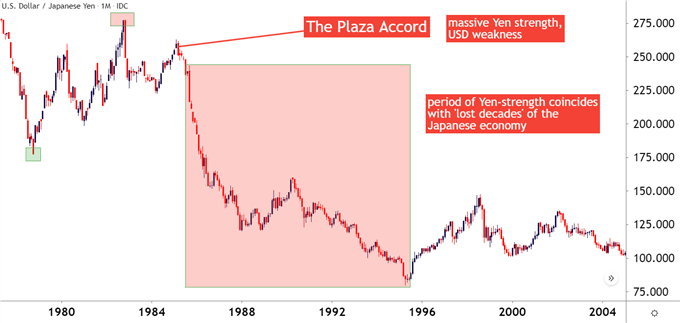The Nucleus of the Forex Market: Trade and Capital Flows (Part 1)
TALKING POINTS:
- The Nucleus of the Forex Market are Trade and Capital Flows
- This article shows why trade and capital flows, driven by currency spot prices, can be so impactful to an economy and a company operating inside of that economy.
- Below, we look at a hypothetical example using real prices and actual scenarios that have impacted the Japanese economy.
Are interest rates the most important element of the forex market?
Pipscollector.com - At the core of the FX market, interest rates are commonly looked to as a primary driver. After all, if an investor can earn interest payments on a daily basis just for being long or short in a pair, there’s motive that can drive capital flows into that currency. And if it’s an increasing rate scenario, where an economy is continually lifting interest rates to keep inflation in-check, this can lead to a prolonged trend in which that currency is bid higher and higher by market participants looking to capture that new, higher rate of return.
But, currencies differ from stocks in that they’re not an isolated asset class: There are repercussions. And too much of a good thing can end up becoming a very bad thing, as seen by the nation of Japan and how the ‘Japanese Economic Miracle’ of post-WWII Japan morphed into the ‘lost decades’ for the Japanese economy.
While the Japanese economy saw strong growth over a 45-year period, a strong Japanese Yen, helped along by the Plaza Accord in 1985, brought upon some significant economic erosion as the economy was mired by three decades of slowing growth and, in some cases, deflation. Below, we look at an example of how this can happen using a very rational outlay.
USD/JPY MONTHLY CHART: 1977-2004

SETTING THE STAGE WITH THE JAPANESE YEN
To fully tell this story we’ve got to go through a quick history lesson with the USD/JPY pair, and the root of this story really drives back to the 70’s and stagflation.
To beat stagflation, Paul Volcker had to raise interest rates to a really high level in the US in the effort of stalling the rampant inflation that was showing at the time. These extremely high interest rates drew significant demand for the US Dollar, driven by the carry trade and rate divergence between the two pairs in the quote.
From the 1978 low to the 1982 high, USD/JPY ran by more than 56%. The pair cooled after Volcker’s policies began to show impact in the US but, from March of 1984 into February of 1985, bulls were in control again, crafting a 1985 high of 262.80 in the USD/JPY pair. And that’s around the time the Plaza Accord came into effect, which was essentially an agreement amongst the G5 to manipulate exchange rates in order to depreciate the US Dollar.
And that’s when the Yen strength really began to show.
See our study on the history of trade wars and their impact on markets!
In the example below, we’re going to look at a hypothetical model using prices from 1998 into 2008, when the USD/JPY exchange rate had depreciated considerably. But, this issue was going on far before that 1998 date for the nation of Japan.
A REAL-WORLD (BUT HYPOTHETICAL EXAMPLE) OF EXCHANGE RATES IN ACTION
Let’s say that a Japanese auto-maker designed a car in 1998; and calculated that it cost them roughly ¥2,800,000 to produce it ($20,000). But, no problem at all - they were going to sell the car for $30,000 - which would allow a very handsome profit of $10,000 on every car sold.
The USDJPY exchange rate in 1995 was roughly ¥140.00. So, we can look at the overall cost and sale of one of these cars below:

So, remember - the value of 1 dollar in 1998 was around ¥140.00 - so it cost ¥2,800,000 to build the car. But, that’s ok - because they were selling it for $30,000, or ¥4,200,000. That left the auto-manufacturer with a nice profit of ¥1,400,000, or $10,000.
If things could stay like this forever, our auto-manufacturer would surely be happy with a 50% profit margin on each car sold.
But things didn’t stay that way. The world has changed massively since 1998.
Continue reading the article in the category Educational content from Pipscollector
- Pipscollector -
